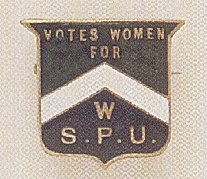[This document comes from Helena Wojtczak's English Social History: Women of Nineteenth-Century Hastings and St.Leonards. An Illustrated Historical Miscellany, which the author has graciously shared with readers of the Victorian Web. The images have been taken from other sources, as specified, and a note and bibliography have been added. Click on the title to obtain the original site, which has additional information.]

In 1903 a breakway suffrage society was founded by NUWSS member Mrs Pankhurst: The Women's Social & Political Union. It became increasingly militant and from 1909 its members were known as the "Suffragettes." From 1910 to 1914 many of its members were taking part in window smashing raids and some committed arson.
A branch of the WSPU opened at 8 Trinity Street (later 8 Claremont), Hastings. Miss Bowker was the Hastings branch secretary, but in 1912 Mary Allen, a famous London suffragette, was sent to take over.

Mrs Massey and Mrs Martel speak to the 'Admiral of the Fishing Fleet' and other Hastings fishermen about votes for women, during the 1908 by-election
Two middle-class St Leonards ladies who joined the WSPU were Elsie Bowerman and Edith Bowerman Chibnall. Elsie sold suffragette newspapers and later worked full-time for the Pankhursts; her mother Edith used to accommodate visiting suffrage speakers, for example Mrs Massey and Mrs Martel (pictured, right), and was injured during a suffragette riot in London.
 Two leading Hastings suffragettes were Mary Hogg (pictured, left) and Mary Tristram, who lived together, in lodgings,
first at 4 Highland Mansions then at 36 Eversfield Place. Miss Hogg was a newspaper vendor with a
pitch at the Memorial from which she sold suffrage papers. In 1916 Miss Hogg became the first woman churchwarden at St Paul's Church, Church Rd St Leonards. She died in 1918. (Miss Tristram later helped create the Girl Guide Movement
and was involved in Civil Defence and the WVS. She died in 1949.) Also active were Mrs Slagg; Mrs Gabb; Mrs MacMunn; Miss Tagg; Miss Naylor; and Miss Canning.
Two leading Hastings suffragettes were Mary Hogg (pictured, left) and Mary Tristram, who lived together, in lodgings,
first at 4 Highland Mansions then at 36 Eversfield Place. Miss Hogg was a newspaper vendor with a
pitch at the Memorial from which she sold suffrage papers. In 1916 Miss Hogg became the first woman churchwarden at St Paul's Church, Church Rd St Leonards. She died in 1918. (Miss Tristram later helped create the Girl Guide Movement
and was involved in Civil Defence and the WVS. She died in 1949.) Also active were Mrs Slagg; Mrs Gabb; Mrs MacMunn; Miss Tagg; Miss Naylor; and Miss Canning.
Miss Canning went up to London one day in May 1914 with a group of local suffragettes, to seek an audience with the King regarding women's suffrage. He declined to receive them and a riot ensued on Constitution Hill, during which there was much police brutality. Miss Canning was arrested. She said later that she would in future refuse to stand up when the National Anthem was played.
Emmeline Pankhurst was chief speaker at rallies held at the Royal Concert Hall in 1910 and 1912. She stayed at the Royal Victoria Hotel. According to David Thornton's book Hastings -- A Living History, when she visited in 1917 she was pelted with flour by bakers from Henry King's, while passing the junction of London Rd and King's Road in an open carriage.
As the campaign wore on, suffragettes nationwide used increasingly violent methods. In 1913 they destroyed Levetleigh, a mansion just vacated by Hastings' MP. This no doubt contributed to the immense hostility in Hastings to the various women's suffrage groups. Suffrage activities met violence from local men, who attacked Miss Billing as she gave an open air speech, mobbed the NUWSS' Hastings office during a meeting, and turned a tax-resistance procession into a riot.
When war broke out in August 1914 over 1,000 British suffragettes had been imprisoned. All the leaders of the WSPU were either serving time, ill or living in exile.
Last modified 2000